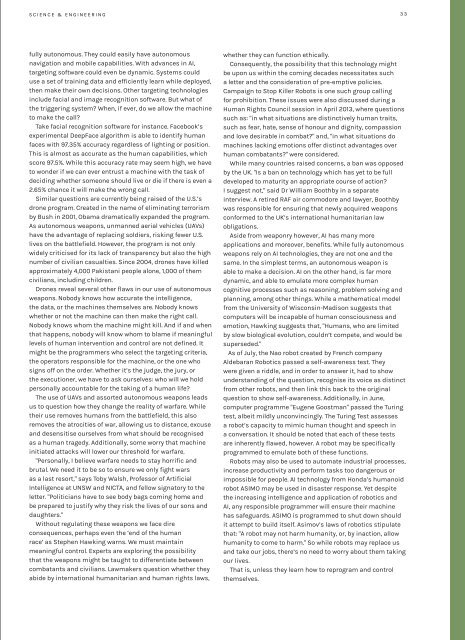Lot's Wife Edition 6 2015
You also want an ePaper? Increase the reach of your titles
YUMPU automatically turns print PDFs into web optimized ePapers that Google loves.
SCIENCE & ENGINEERING 33<br />
fully autonomous. They could easily have autonomous<br />
navigation and mobile capabilities. With advances in AI,<br />
targeting software could even be dynamic. Systems could<br />
use a set of training data and efficiently learn while deployed,<br />
then make their own decisions. Other targeting technologies<br />
include facial and image recognition software. But what of<br />
the triggering system? When, if ever, do we allow the machine<br />
to make the call?<br />
Take facial recognition software for instance. Facebook’s<br />
experimental DeepFace algorithm is able to identify human<br />
faces with 97.35% accuracy regardless of lighting or position.<br />
This is almost as accurate as the human capabilities, which<br />
score 97.5%. While this accuracy rate may seem high, we have<br />
to wonder if we can ever entrust a machine with the task of<br />
deciding whether someone should live or die if there is even a<br />
2.65% chance it will make the wrong call.<br />
Similar questions are currently being raised of the U.S.’s<br />
drone program. Created in the name of eliminating terrorism<br />
by Bush in 2001, Obama dramatically expanded the program.<br />
As autonomous weapons, unmanned aerial vehicles (UAVs)<br />
have the advantage of replacing soldiers, risking fewer U.S.<br />
lives on the battlefield. However, the program is not only<br />
widely criticised for its lack of transparency but also the high<br />
number of civilian casualties. Since 2004, drones have killed<br />
approximately 4,000 Pakistani people alone, 1,000 of them<br />
civilians, including children.<br />
Drones reveal several other flaws in our use of autonomous<br />
weapons. Nobody knows how accurate the intelligence,<br />
the data, or the machines themselves are. Nobody knows<br />
whether or not the machine can then make the right call.<br />
Nobody knows whom the machine might kill. And if and when<br />
that happens, nobody will know whom to blame if meaningful<br />
levels of human intervention and control are not defined. It<br />
might be the programmers who select the targeting criteria,<br />
the operators responsible for the machine, or the one who<br />
signs off on the order. Whether it’s the judge, the jury, or<br />
the executioner, we have to ask ourselves: who will we hold<br />
personally accountable for the taking of a human life?<br />
The use of UAVs and assorted autonomous weapons leads<br />
us to question how they change the reality of warfare. While<br />
their use removes humans from the battlefield, this also<br />
removes the atrocities of war, allowing us to distance, excuse<br />
and desensitise ourselves from what should be recognised<br />
as a human tragedy. Additionally, some worry that machine<br />
initiated attacks will lower our threshold for warfare.<br />
"Personally, I believe warfare needs to stay horrific and<br />
brutal. We need it to be so to ensure we only fight wars<br />
as a last resort," says Toby Walsh, Professor of Artificial<br />
Intelligence at UNSW and NICTA, and fellow signatory to the<br />
letter. "Politicians have to see body bags coming home and<br />
be prepared to justify why they risk the lives of our sons and<br />
daughters."<br />
Without regulating these weapons we face dire<br />
consequences, perhaps even the ‘end of the human<br />
race’ as Stephen Hawking warns. We must maintain<br />
meaningful control. Experts are exploring the possibility<br />
that the weapons might be taught to differentiate between<br />
combatants and civilians. Lawmakers question whether they<br />
abide by international humanitarian and human rights laws,<br />
whether they can function ethically.<br />
Consequently, the possibility that this technology might<br />
be upon us within the coming decades necessitates such<br />
a letter and the consideration of pre-emptive policies.<br />
Campaign to Stop Killer Robots is one such group calling<br />
for prohibition. These issues were also discussed during a<br />
Human Rights Council session in April 2013, where questions<br />
such as: "in what situations are distinctively human traits,<br />
such as fear, hate, sense of honour and dignity, compassion<br />
and love desirable in combat?" and, "in what situations do<br />
machines lacking emotions offer distinct advantages over<br />
human combatants?" were considered.<br />
While many countries raised concerns, a ban was opposed<br />
by the UK. "Is a ban on technology which has yet to be full<br />
developed to maturity an appropriate course of action?<br />
I suggest not," said Dr William Boothby in a separate<br />
interview. A retired RAF air commodore and lawyer, Boothby<br />
was responsible for ensuring that newly acquired weapons<br />
conformed to the UK’s international humanitarian law<br />
obligations.<br />
Aside from weaponry however, AI has many more<br />
applications and moreover, benefits. While fully autonomous<br />
weapons rely on AI technologies, they are not one and the<br />
same. In the simplest terms, an autonomous weapon is<br />
able to make a decision. AI on the other hand, is far more<br />
dynamic, and able to emulate more complex human<br />
cognitive processes such as reasoning, problem solving and<br />
planning, among other things. While a mathematical model<br />
from the University of Wisconsin-Madison suggests that<br />
computers will be incapable of human consciousness and<br />
emotion, Hawking suggests that, "Humans, who are limited<br />
by slow biological evolution, couldn’t compete, and would be<br />
superseded."<br />
As of July, the Nao robot created by French company<br />
Aldebaran Robotics passed a self-awareness test. They<br />
were given a riddle, and in order to answer it, had to show<br />
understanding of the question, recognise its voice as distinct<br />
from other robots, and then link this back to the original<br />
question to show self-awareness. Additionally, in June,<br />
computer programme "Eugene Goostman" passed the Turing<br />
test, albeit mildly unconvincingly. The Turing Test assesses<br />
a robot’s capacity to mimic human thought and speech in<br />
a conversation. It should be noted that each of these tests<br />
are inherently flawed, however. A robot may be specifically<br />
programmed to emulate both of these functions.<br />
Robots may also be used to automate industrial processes,<br />
increase productivity and perform tasks too dangerous or<br />
impossible for people. AI technology from Honda’s humanoid<br />
robot ASIMO may be used in disaster response. Yet despite<br />
the increasing intelligence and application of robotics and<br />
AI, any responsible programmer will ensure their machine<br />
has safeguards. ASIMO is programmed to shut down should<br />
it attempt to build itself. Asimov’s laws of robotics stipulate<br />
that: "A robot may not harm humanity, or, by inaction, allow<br />
humanity to come to harm." So while robots may replace us<br />
and take our jobs, there’s no need to worry about them taking<br />
our lives.<br />
That is, unless they learn how to reprogram and control<br />
themselves.

















